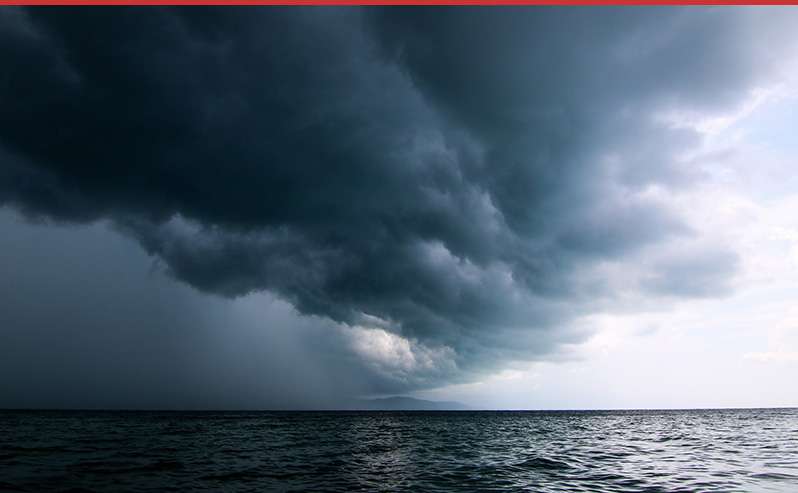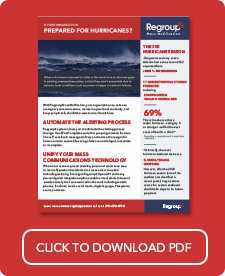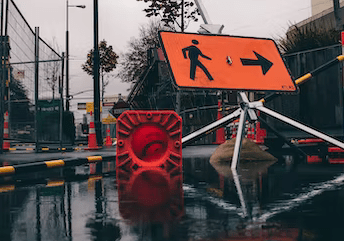
Regroup Guide: Is Your Organization Prepared for Hurricanes?

A common mistake for many individuals and organizations is growing indifferent to the risks associated with tropical storms and hurricanes because their region has not been affected in recent years. However, 2004’s hurricane Charley proved that models and forecasts can only predict so much. In August of that year, Charley took an almost boomerang-like turn as a Category 4 storm and traveled across the state of Florida, causing over $16 billion in losses and 15 fatalities.
So, how can communication aid your emergency preparedness during hurricane season or other severe weather events? Read on.
AUTOMATE THE ALERTING PROCESS
Regroup’s system allows you to automate the alerting process through QuickPost Templates and other pre-programmed features. This will accelerate message delivery and reduce the margin for human error to ensure life-saving alerts are not delayed, inaccurate or incomplete.
UNIFY YOUR MASS COMMUNICATIONS TECHNOLOGY
When a hurricane is poised to strike, personnel won’t have time to manually push critical alerts to all mass communication technologies being leveraged. Regroup’s Open API and many pre-configured integration options enable critical alerts to be sent simultaneously to all communication channels including mobile phones, landlines, email, social media, digital signage, PA systems, sirens and more.
LEVERAGE FEDERAL ALERTING TECHNOLOGY
Regroup allows your organization to receive and send notifications from federal alert systems including FEMA’s Integrated Public Alert Warning System (IPAWS), the National Weather Service (NWS), and the National Oceanic and Atmospheric Administration (NOAA). When combined with automated messaging functionality, advance warnings, storm updates, and the final all-clear messages can be automatically broadcast to your recipients through multiple communication channels.
REACH RECIPIENTS IN SPECIFIC LOCATIONS WITH GEO-TARGETED MESSAGING
Only Regroup’s GeoFence messaging empowers you to alert your recipients with specific messages when they are located inside or outside of specified areas on a map. Simply draw the location you want to target and you can easily define pre-programmed entry, exit, and in-area messages to be sent to recipients.
INSULATE AGAINST LOCAL INFRASTRUCTURE FAILURES
The free mobile app from Regroup allows your recipients to receive messages via push notification in addition to SMS. Push notifications use satellite-based technology to communicate to mobile devices, so alerts are delivered even in severe weather and when cell towers and local networks fail.
INCREASE SITUATIONAL INTELLIGENCE WITH ENHANCED REPLIES
Regroup’s enhanced replies feature an excellent tool during critical events like a hurricane. When you ask for status updates or request responses, recipients have multiple ways to respond quickly and easily from wherever they are. Use this standard Regroup feature to determine the status of employees, gather on-the-scene reports, and confirm the availability of critical personnel.
FACILITATE ON-THE-FLY COLLABORATION
.A secure mobile app like Regroup’s mobile app with encrypted push notification technology, ensures geographically dispersed response teams can communicate and collaborate during adverse local conditions. Keep the lines of communication open — even during widespread power outages and when cellular networks are out of service or overloaded.
 HURRICANE PREPAREDNESS CHECKLIST – EVALUATE YOUR RISKS AND ORGANIZE KEY INFORMATION:
HURRICANE PREPAREDNESS CHECKLIST – EVALUATE YOUR RISKS AND ORGANIZE KEY INFORMATION:
- Organize the names and contact information for all individuals you will need to communicate with if a hurricane strikes your area. Make sure this list is available to multiple people.
- Designate people for emergency response teams, including crisis communications, business continuity, and disaster recovery personnel within your organization
- In advance of a hurricane, clearly communicate operational plans for different scenarios with staff or other members of your organization
- Review evacuation procedures, including maps that show evacuation route Know where to find your site and building plans in case they are needed
Write out processes for assessing damage, along with information for contractors that might be needed following a hurricane strike - Detail how you will communicate with management, employees, external stakeholders and the media during and following an event
- Evaluate your data security and accessibility; is key information stored on an off-site server that can be accessed remotely by multiple team members, from multiple locations?
TEST AND PRACTICE YOUR EMERGENCY PREPAREDNESS PLAN:
- Evaluate and practice your emergency preparedness plan at least once a year
- Involve all internal and external response teams in preparedness drills, including applicable public safety officials
- Utilize a notification system, like Regroup Mass Notification, to communicate with teams and simulate established emergency communication protocols
- Test alarm systems and sirens that will be utilized during an event
- Ensure members of emergency response and/or business continuity teams can be alerted to respond at any hour of the day or night
 USE AN EMERGENCY NOTIFICATION SYSTEM TO INCREASE AWARENESS AND HURRICANE PREPAREDNESS:
USE AN EMERGENCY NOTIFICATION SYSTEM TO INCREASE AWARENESS AND HURRICANE PREPAREDNESS:
- Create hurricane-specific message templates that can be deployed quickly if they’re ever needed Schedule preparedness messages to be sent at regular intervals
- Transmit preparedness resources and notices about scheduled drills
- Ask your employees and other contacts to verify their contact information and preferred methods of communication
- Train your recipients, including response team members, how to respond to messages during an actual event
- Remind team leaders and other key personnel to review and update their departmental preparedness plans as needed
Your Next Steps
Regroup Mass Notification provides a number of smart integrations that auto-alert your entire network during severe weather events. We can show you how to harness a mass notification protocol to protect your organization during emergencies and improve your routine communications.
Schedule a no-hassle demonstration of the Regroup platform and learn more about ensuring the safety of your team and assets.
 HURRICANE PREPAREDNESS CHECKLIST – EVALUATE YOUR RISKS AND ORGANIZE KEY INFORMATION:
HURRICANE PREPAREDNESS CHECKLIST – EVALUATE YOUR RISKS AND ORGANIZE KEY INFORMATION: USE AN EMERGENCY NOTIFICATION SYSTEM TO INCREASE AWARENESS AND HURRICANE PREPAREDNESS:
USE AN EMERGENCY NOTIFICATION SYSTEM TO INCREASE AWARENESS AND HURRICANE PREPAREDNESS: